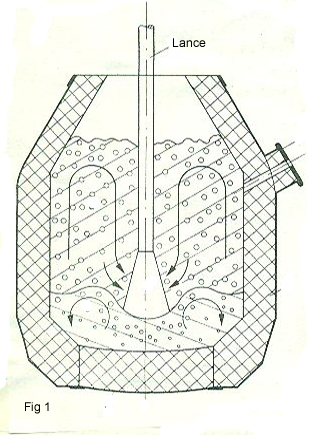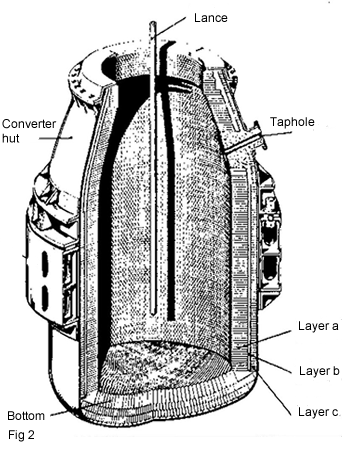Steelmaking (technology)
Steel production depends on the availability of raw materials such as pig iron, scrap and sponge iron. There are two fundamentally different methods:
- Converter process: blowing oxygen into liquid iron (pig iron)
- Electrical Arc Furnace: smelting iron –containing materials, such as scrap and sponge iron
The purposes of all steel production processes is the removal of unwanted metallic, nonmetalic and gas-forming elements from pig iron and produce the various grades of steel. There are several method as follow:
Converter Process
LD or BOF (Basic oxygen Furnaces)
The first LD (Linz –Donawitz ) converter, with a capacity of 30 ton was operated in LinZ(Austria) in 1952.By this process pure oxygen will be blown through a lance in the molten iron. the following reaction will be occurred during 10 to 20 min reaction process:
C + O2 = 2CO ∆H = -221 kJ
2Fe + O2 = 2FeO ∆H = -529 kJ
Si + O2 = SiO2 ∆H = -878 kJ
2Mn +O2 =2MnO ∆H = -771 kJ
The exothermic oxidation of metalloids dissolved in the iron produced the necessary heating for the refining process. No external heating is necessary and most of the heat generated from the oxidation o f Si, Mn and another elements. By this process the temperature is about 1650 oC and about 30 % scrap can be used as charge materials. In converter oxygen might be blown at carefully monitored rates for up to 20 minutes .The actual blowing rate and lance height are monitored and controlled by a computer which preprogramed is linked by various controlling sensors. Figure 1 shows the refining of steel by BOF process.

The lining of a converter usually consists of a number of layers (fig2):
- a) The working layer which is in direct contact with slag, metal and gases; it is made periclase –spinelide or tar-dolomite brick and renewed after each campaign
- b) An intermediate layer, usually made of tar-dolomite mixture
- c) The reinforcing layer immediately at the inner side of the converter shell to prevent its overheating and burning- through; it is made of magnesite –chromite brick.
The bottom of converters is also laid in a few layers: the bottom layer of fireclay brick, then a few layers of magnesite brick and above them a layer of tar-dolomite brick.

Lances
Oxygen lances should supply oxygen at the specified flow rate and form the jet the desired shape, have a sufficiently high durability and the simple in design. The rate of oxygen supply is usually 5-6 m3/min.t up to 2800 m3 of oxygen at a pressure of 1-1.5 MPa is supplied every minute into a 350 ton converter. Oxygen lance may have several copper nozzles and will be cooled with water (figures 1&2).
For more information please contact us.

